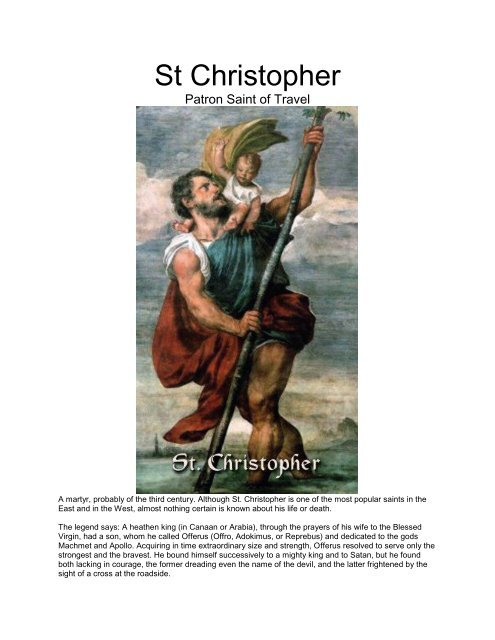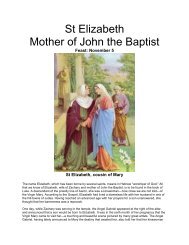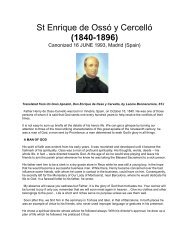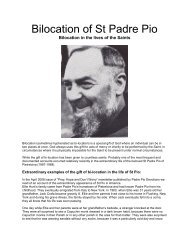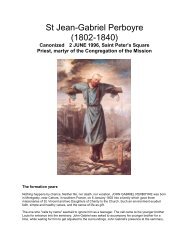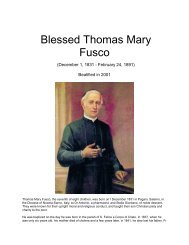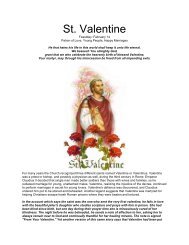St Christopher - The Mystical Side of God
St Christopher - The Mystical Side of God
St Christopher - The Mystical Side of God
- No tags were found...
You also want an ePaper? Increase the reach of your titles
YUMPU automatically turns print PDFs into web optimized ePapers that Google loves.
<strong>St</strong> <strong>Christopher</strong>Patron Saint <strong>of</strong> TravelA martyr, probably <strong>of</strong> the third century. Although <strong>St</strong>. <strong>Christopher</strong> is one <strong>of</strong> the most popular saints in theEast and in the West, almost nothing certain is known about his life or death.<strong>The</strong> legend says: A heathen king (in Canaan or Arabia), through the prayers <strong>of</strong> his wife to the BlessedVirgin, had a son, whom he called Offerus (Offro, Adokimus, or Reprebus) and dedicated to the godsMachmet and Apollo. Acquiring in time extraordinary size and strength, Offerus resolved to serve only thestrongest and the bravest. He bound himself successively to a mighty king and to Satan, but he foundboth lacking in courage, the former dreading even the name <strong>of</strong> the devil, and the latter frightened by thesight <strong>of</strong> a cross at the roadside.
For a time his search for a new master was in vain, but at last he found a hermit (Babylas?) whotold him to <strong>of</strong>fer his allegiance to Christ, instructed him in the Faith, and baptized him.<strong>Christopher</strong>, as he was now called, would not promise to do any fasting or praying, but willinglyaccepted the task <strong>of</strong> carrying people, for <strong>God</strong>'s sake, across a raging stream. One day he wascarrying a child who continually grew heavier, so that it seemed to him as if he had the wholeworld on his shoulders. <strong>The</strong> child, on inquiry, made himself known as the Creator and Redeemer<strong>of</strong> the world. To prove his statement the child ordered <strong>Christopher</strong> to fix his staff in the ground.<strong>The</strong> next morning it had grown into a palm-tree bearing fruit. <strong>The</strong> miracle converted many. Thisexcited the rage <strong>of</strong> the king (prefect) <strong>of</strong> that region (Dagnus <strong>of</strong> Samos in Lycia?). <strong>Christopher</strong> wasput into prison and, after many cruel torments, beheaded.<strong>The</strong> Greek legend may belong to the sixth century; about the middle <strong>of</strong> the ninth, we find it spreadthrough France. Originally, <strong>St</strong>. <strong>Christopher</strong> was only a martyr, and as such is recorded in the oldmartyrologies. <strong>The</strong> simple form <strong>of</strong> the Greek and Latin passio soon gave way to more elaborate legends.We have the Latin edition in prose and verse <strong>of</strong> 983 by the subdeacon Walter <strong>of</strong> Speyer, "<strong>The</strong>saurusanecdotorum novissimus" (Augsburg, 1721-23), II, 27-142, and Harster, "Walter von Speyer" (1878). Anedition <strong>of</strong> the eleventh century is found in the Acta SS., and another in the "Golden Legend" <strong>of</strong> Jacob deVoragine. <strong>The</strong> idea conveyed in the name, at first understood in the spiritual sense <strong>of</strong> bearing Christ inthe heart, was in the twelfth or thirteenth century taken in the realistic meaning and became thecharacteristic <strong>of</strong> the saint. <strong>The</strong> fact that he was frequently called a great martyr may have given rise to thestory <strong>of</strong> his enormous size. <strong>The</strong> stream and the weight <strong>of</strong> the child may have been intended to denote thetrials and struggles <strong>of</strong> a soul taking upon itself the yoke <strong>of</strong> Christ in this world.<strong>The</strong> existence <strong>of</strong> a martyr <strong>St</strong>. <strong>Christopher</strong> cannot be denied, as was sufficiently shown by the JesuitNicholas Serarius, in his treatise on litanies, "Litaneutici" (Cologne, 1609), and by Molanus in his history<strong>of</strong> sacred pictures, "De picturis et imaginibus sacris" (Louvain, 1570). In a small church dedicated to themartyr <strong>St</strong>. <strong>Christopher</strong>, the body <strong>of</strong> <strong>St</strong>. Remigius <strong>of</strong> Reims was buried, 532 (Acta SS., 1 Oct., 161). <strong>St</strong>.Gregory the Great (d. 604) speaks <strong>of</strong> a monastery <strong>of</strong> <strong>St</strong>. <strong>Christopher</strong> (Epp., x., 33). <strong>The</strong> MozarabicBreviary and Missal, ascribed to <strong>St</strong>. Isidore <strong>of</strong> Seville (d. 636), contains a special <strong>of</strong>fice in his honour. In1386 a brotherhood was founded under the patronage <strong>of</strong> <strong>St</strong>. <strong>Christopher</strong> in Tyrol and Vorarlberg, to guidetravellers over the Arlberg. In 1517, a <strong>St</strong>. <strong>Christopher</strong> temperance society existed in Carinthia, <strong>St</strong>yria, inSaxony, and at Munich. Great veneration was shown to the saint in Venice, along the shores <strong>of</strong> theDanube, the Rhine, and other rivers where floods or ice-jams caused frequent damage. <strong>The</strong> oldestpicture <strong>of</strong> the saint, in the monastery on the Mount Sinai dates from the time <strong>of</strong> Justinian (527-65). Coinswith his image were cast at Würzburg, in Würtemberg, and in Bohemia.His statues were placed at the entrances <strong>of</strong> churches and dwellings, and frequently at bridges; thesestatues and his pictures <strong>of</strong>ten bore the inscription: "Whoever shall behold the image <strong>of</strong> <strong>St</strong>. <strong>Christopher</strong>shall not faint or fall on that day." <strong>The</strong> saint, who is one <strong>of</strong> the fourteen holy helpers, has been chosen aspatron by Baden, by Brunswick, and by Mecklenburg, and several other cities, as well as by bookbinders,gardeners, mariners, etc. He is invoked against lightning, storms, epilepsy, pestilence, etc. His feast iskept on 25 July; among the Greeks, on 9 March; and his emblems are the tree, the Christ Child, and astaff. <strong>St</strong>. <strong>Christopher</strong>'s Island (commonly called <strong>St</strong>. Kitts), lies 46 miles west <strong>of</strong> Antigua in the LesserAntilles.Reference:http://www.newadvent.org/cathen/03728a.htm


